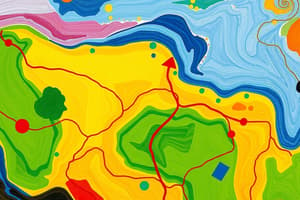Podcast
Questions and Answers
What essential component must be included in a complete sketch map?
What essential component must be included in a complete sketch map?
- A compass rose (correct)
- Population statistics
- Historical landmarks
- Weather information
How do you correctly describe a route using cardinal points?
How do you correctly describe a route using cardinal points?
- By indicating directions like north, south, east, and west (correct)
- By providing the travel time between locations
- By referencing landmarks only
- By using numerical distances only
What does a map key typically represent?
What does a map key typically represent?
- The elevation of the terrain
- The symbols and their meanings used on the map (correct)
- The population density of the area
- The history of the mapped locations
What is the primary use of coordinates in degrees?
What is the primary use of coordinates in degrees?
When measuring indirect distances on a map, what tool can you use?
When measuring indirect distances on a map, what tool can you use?
Flashcards are hidden until you start studying
Study Notes
Map Skills
- Street maps and local maps provide information about specific locations.
- Grid systems on maps (e.g., Block B1) help locate places.
- Describe directions using the 8 cardinal points (North, South, East, West, Northeast, Northwest, Southeast, Southwest).
- Map keys explain symbols used on the map.
Sketch Maps
- Sketch maps visually represent routes between places.
- Determine compass directions (North, South, East, West) while sketching.
- A complete sketch map includes:
- Symbols to represent various features.
- A key that explains the symbols used.
- Scale for representing distances.
- Observations about the route or place.
- Compass directions to show orientation.
Coordinates
- Coordinates in degrees (e.g., 40° N, 74° W) represent location on a map.
- Coordinates can be expressed in degrees and minutes (e.g., 40° 45' N, 74° 00' W).
Distance and Scale
- Line scales show distances using measurements like centimeters or inches.
- Word scales express distances with words (e.g., 1 cm = 1 km).
- Small-scale maps cover a large geographical area with less detail.
- Large-scale maps cover a smaller area with more detail.
- Measure distances using string or the paper method when a direct measurement isn't possible.
- Calculate distances using map scales.
- Direct routes use straight line measurements.
- Indirect routes measure along curved paths.
Studying That Suits You
Use AI to generate personalized quizzes and flashcards to suit your learning preferences.




